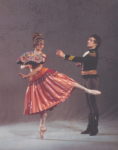Fonteyn, Margot
Margot Fonteyn Photos
Introduction
Margot Fonteyn, born on May 18, 1919, and passing away on February 21, 1991, is widely regarded as one of the greatest ballerinas of the 20th century. Her significance in the world of ballet is unparalleled, as she not only captivated audiences with her extraordinary talent but also played a pivotal role in elevating British ballet to international acclaim. Fonteyn’s career was marked by numerous key achievements, including her long-standing association with The Royal Ballet, her iconic partnership with Rudolf Nureyev, and her contributions to the development of ballet as an art form. Her legacy continues to inspire dancers and choreographers around the world.
Early Life and Background
Margot Fonteyn was born as Margaret Evelyn Hookham in Reigate, Surrey, England. Her father, Felix Hookham, was a British engineer, and her mother, Hilda, was of Irish and Brazilian descent. Fonteyn’s early life was marked by frequent relocations due to her father’s work, including a significant period spent in China. It was during her time in Shanghai that Fonteyn began her formal dance training under the tutelage of Russian émigré teachers.
Fonteyn’s initial introduction to dance came at a young age, and she quickly demonstrated a natural talent and passion for ballet. Her early training was rigorous, and she was fortunate to study under some of the most respected teachers of the time, including Serafina Astafieva and Olga Preobrajenska. These formative years laid the foundation for her future success and instilled in her a deep love for the art of ballet.
Rise to Prominence
Fonteyn’s rise to prominence began in earnest when she joined the Vic-Wells Ballet (later known as The Royal Ballet) in 1934 at the age of 15. Her first major role came in 1935 when she danced the lead in “Giselle,” a performance that garnered critical acclaim and established her as a rising star in the ballet world. Over the next few years, Fonteyn continued to take on increasingly significant roles, captivating audiences with her grace, technical prowess, and emotional depth.
During her early career, Fonteyn faced several challenges, including the outbreak of World War II, which disrupted the ballet world and led to the temporary closure of many companies. Despite these obstacles, Fonteyn’s dedication and talent shone through, and she quickly became one of the leading dancers of her generation. Her association with The Royal Ballet, under the direction of Ninette de Valois, provided her with a platform to showcase her abilities and collaborate with some of the most influential figures in ballet.
Career Highlights
Margot Fonteyn’s career is marked by numerous highlights that solidified her status as a ballet icon. One of her most significant achievements was her partnership with Rudolf Nureyev, which began in 1961. Their onstage chemistry and technical brilliance created some of the most memorable performances in ballet history. Together, they danced in iconic productions such as “Swan Lake,” “Romeo and Juliet,” and “Giselle,” captivating audiences worldwide.
Fonteyn’s repertoire included a wide range of roles, from classical ballets to contemporary works. Some of her signature roles included Aurora in “The Sleeping Beauty,” Odette/Odile in “Swan Lake,” and Juliet in “Romeo and Juliet.” Her ability to bring depth and nuance to each character she portrayed set her apart as a truly exceptional artist.
Throughout her career, Fonteyn received numerous awards and honors, including being named a Dame Commander of the Order of the British Empire (DBE) in 1956. Her contributions to ballet were recognized not only in the United Kingdom but also internationally, cementing her legacy as one of the greatest ballerinas of all time.
Style and Technique
Margot Fonteyn’s unique style and approach to dance were characterized by her exceptional grace, fluidity, and emotional expressiveness. Her technique was marked by a perfect blend of strength and delicacy, allowing her to execute even the most challenging movements with apparent ease. Fonteyn’s ability to convey deep emotion through her performances made her a favorite among audiences and critics alike.
Fonteyn’s technique and style influenced many dancers who came after her. Her emphasis on musicality, precision, and storytelling set a standard for future generations of ballerinas. She was known for her meticulous attention to detail and her ability to make every movement appear effortless, qualities that continue to inspire dancers today.
Repertoire
- “The Sleeping Beauty” (Aurora)
- “Swan Lake” (Odette/Odile)
- “Romeo and Juliet” (Juliet)
- “Giselle” (Giselle)
- “Cinderella” (Cinderella)
- “Sylvia” (Sylvia)
- “Ondine” (Ondine)
Legacy and Influence
Margot Fonteyn’s legacy in the ballet community is profound and enduring. She is remembered not only for her extraordinary talent but also for her dedication to the art form and her role in elevating British ballet to international prominence. Fonteyn’s influence extends beyond her performances; she inspired countless dancers and choreographers to pursue excellence in their craft.
Fonteyn’s impact on the cultural and artistic landscape is significant. She helped to popularize ballet in the United Kingdom and around the world, bringing the art form to new audiences and ensuring its continued relevance. Her partnership with Rudolf Nureyev, in particular, is often credited with revitalizing interest in classical ballet during the 1960s and 1970s.
Personal Life and Anecdotes
Outside of her illustrious career, Margot Fonteyn led a life filled with interesting anecdotes and personal stories. She was known for her elegance, charm, and warm personality. Fonteyn’s marriage to Panamanian diplomat Roberto Arias in 1955 added an intriguing dimension to her life, as she balanced her demanding career with her role as a diplomat’s wife.
One notable anecdote from Fonteyn’s life involves her involvement in an attempted coup in Panama in 1959. Her husband, Roberto Arias, was implicated in the plot, and Fonteyn herself was briefly detained. Despite this dramatic episode, Fonteyn’s dedication to ballet never wavered, and she continued to perform at the highest level.
Later Years and Retirement
Margot Fonteyn officially retired from the stage in 1979, after a career spanning more than four decades. Following her retirement, she remained active in the ballet community, taking on roles as a teacher, mentor, and advocate for the arts. Fonteyn’s contributions to ballet extended beyond her performances, as she worked to support and nurture the next generation of dancers.
In her later years, Fonteyn reflected on her career and life in interviews and autobiographies. She spoke candidly about the challenges and triumphs she experienced, offering valuable insights into the world of ballet. Fonteyn’s passing in 1991 marked the end of an era, but her legacy continues to live on through her recordings, writings, and the countless dancers she inspired.
FAQ
What makes Margot Fonteyn so famous?
Margot Fonteyn is famous for her extraordinary talent, grace, and emotional expressiveness as a ballerina. Her long-standing association with The Royal Ballet and her iconic partnership with Rudolf Nureyev further solidified her status as one of the greatest dancers of the 20th century.
Which roles is Margot Fonteyn best known for?
Margot Fonteyn is best known for her roles in “The Sleeping Beauty” (Aurora), “Swan Lake” (Odette/Odile), “Romeo and Juliet” (Juliet), and “Giselle” (Giselle). These performances showcased her exceptional technique and emotional depth.
How has Margot Fonteyn contributed to the evolution of ballet?
Margot Fonteyn contributed to the evolution of ballet by elevating British ballet to international prominence, inspiring future generations of dancers, and setting a standard for excellence in performance. Her partnership with Rudolf Nureyev also revitalized interest in classical ballet during the 1960s and 1970s.
What are the key challenges faced by Margot Fonteyn in her career?
Margot Fonteyn faced several challenges in her career, including the outbreak of World War II, which disrupted the ballet world, and personal challenges such as her involvement in an attempted coup in Panama. Despite these obstacles, her dedication and talent allowed her to overcome these challenges and achieve great success.
How is Margot Fonteyn currently influencing the ballet community?
Although Margot Fonteyn passed away in 1991, her influence on the ballet community remains strong. Her recordings, writings, and the dancers she inspired continue to shape the art form. Fonteyn’s emphasis on musicality, precision, and storytelling set a standard that dancers strive to emulate today.
When was Margot Fonteyn born?
Margot Fonteyn was born on May 18, 1919.
When did Margot Fonteyn pass away?
Margot Fonteyn passed away on February 21, 1991.
Conclusion
Margot Fonteyn’s enduring impact on ballet is a testament to her extraordinary talent, dedication, and passion for the art form. Her performances continue to inspire and captivate audiences, and her influence on future generations of dancers and choreographers is immeasurable. As we reflect on her remarkable career and contributions, it is clear that Margot Fonteyn holds a special place in the history of ballet. Her legacy serves as a reminder of the power of dance to move, inspire, and transform, and her work will continue to be celebrated for years to come.




